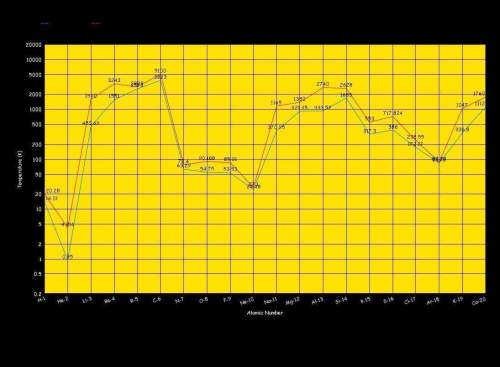Analysis and conclusions
looking at the line plots on your graph, describe how boiling point an...

Chemistry, 21.07.2019 23:10 lunarStudios123
Analysis and conclusions
looking at the line plots on your graph, describe how boiling point and melting point vary with respect to atomic number.
now look at the segment of the graph between the two data points marked with black squares. describe how the boiling point and melting point plots behave between these points. be as specific as possible.
on your graph, the data points between the black squares are data for elements with atomic numbers 3 through 9. locate these elements on your periodic table. what term or description would you use to identify these elements with respect to the periodic table?
now look at the green lines you created by connecting the three boiling point data points and the three melting point data points. for each of these lines, describe any trends you see.
locate the elements on your periodic table that you circled in green on your graph. what term or description would you use to identify these elements with respect to the periodic table?
after reviewing your answers to questions 2 and 4 above, would you define boiling point and melting point as a periodic table family trend (vertical groups), period trend (horizontal rows), or neither? explain your answer.
using the room temperature line (orange line) and your periodic table, make lists that identify the state of matter (gas, liquid, or solid) in which each element you plotted exists at room temperature. explain your answers.


Answers: 3
Another question on Chemistry

Chemistry, 22.06.2019 22:30
Is the idea of spontaneous generation supported by redi's experiment? justify your answer in 2-3 sentences?
Answers: 1

Chemistry, 23.06.2019 10:30
Ethyl alcohol, also known as ethanol, has a density of 0.79 g/ml. what is the volume, in quarts, of 1.95 kg of this alcohol?
Answers: 2

Chemistry, 23.06.2019 14:20
What kind of chemical reaction does the chemical equation sodium + chlorine → sodium chloride represent? a. combustion b. decomposition c. single replacement d. synthesis
Answers: 1

Chemistry, 23.06.2019 14:50
Select the correct answer from each drop-down menu. in the process of nuclear fission, . fission only happens to very atoms. the fission process usually also produces several free .
Answers: 2
You know the right answer?
Questions




English, 05.03.2020 13:38


Computers and Technology, 05.03.2020 13:39






Spanish, 05.03.2020 13:40







Mathematics, 05.03.2020 13:41



